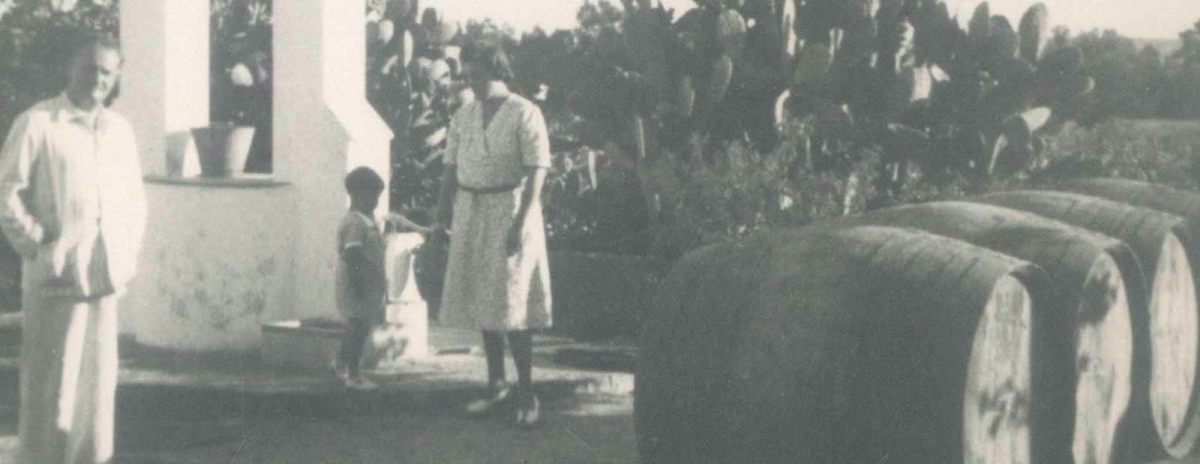
Photo by Eduardo Pereiras. Boots crafted in the 50s to press grapes. Artisans have been an important part of our identity but also out daily life. Crédito a Eduardo Pereiras.
It’s that time of year again, when the cold starts to break and warmer weather gradually begins to grace us with its presence.As the seasons change, we often seek out and welcome food and drink that reflects our surroundings.When things start to heat up, our desire for beverages that quench our thirst and cool us off grows exponentially with the increase in temperature.In a world filled with slushies and punches, there is one classic cocktail that has been helping us usher in Spring and Summer for centuries: Sangria
Our history has endless examples where early jobs have time and again disappeared and will never come back. Often, these shameful losses also chip away the intellectual property of those civilizations and their traditions. This is exactly why we give tremendous importance to the Almacenistas in Jerez, and the inestimable contributions to the winemaking legacy that the region still has to offer.
But what is an Almacenista? The actual term (the legal definition is: Bodega de Crianza y Almacenado) may suggest a meaning related to the activity that these specific producers have been carrying out for centuries: craftsmen and women dedicated to aging wines in the Marco de Jerez… small, artisanal, family-owned, run by prominent individuals… and that hold with pride some of the highest-quality wines to be found in the whole denomination of origin. To fully appreciate the singularity of sherry wines, one must first know the long and consequential role of the Almacenistas in the Triangle. To that end, our certification study program on these celebrated wines, the CSWS®, extensively covers that fact.
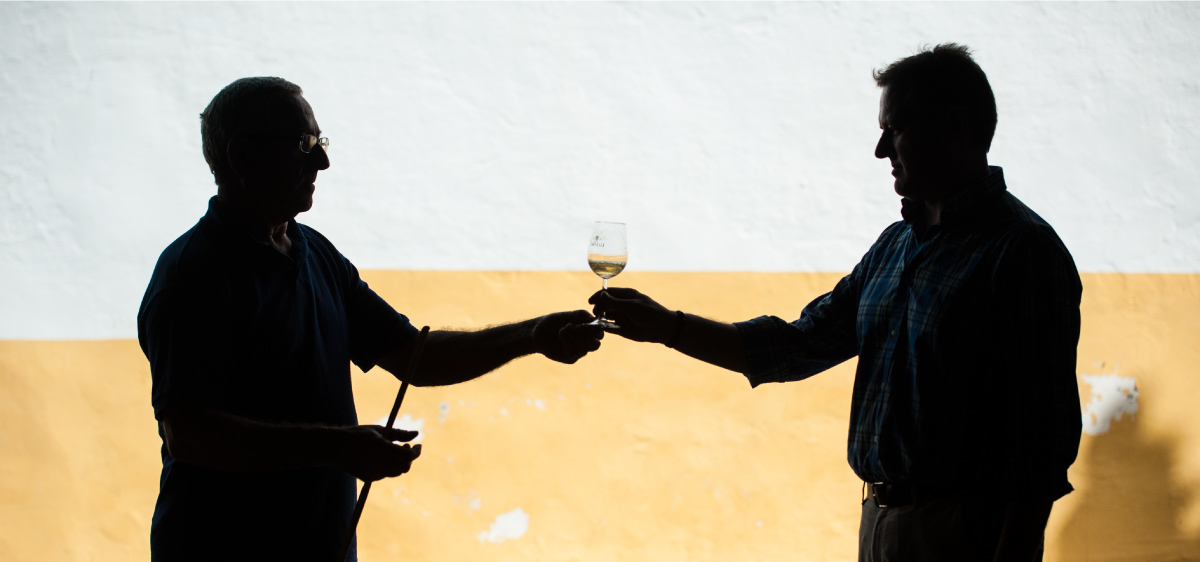
Small, artisanal, family-owned, run by prominent individuals… and that hold with pride some of the highest-quality wines to be found in the whole denomination of origin.
Now, how to officially classify an Almacenista producer? Their nature is complex and subject to the owners’ personal decisions, based on, say, family traditions, or actual capacity limits, with some choosing to perform a broad spectrum of business models. Some may have vineyards and produce wines solely from their own grapes, age them at will, and then sell them out in bulk on their premises while others may sustain their supplies by buying young wines from large base-wine producers (like the Cooperatives), to then sell their aged wines to a single (or a few) Bodegas de Crianza y Expedición (Sherry Houses) years later. The possibilities they have are many, and there is a ‘personal’ component that might have determined the scope of their activity at a specific time in history. Also, several weight-carrying factors such as historic, productive and/or geographical features might potentially alter the general occupation of these unique type of bodegas.
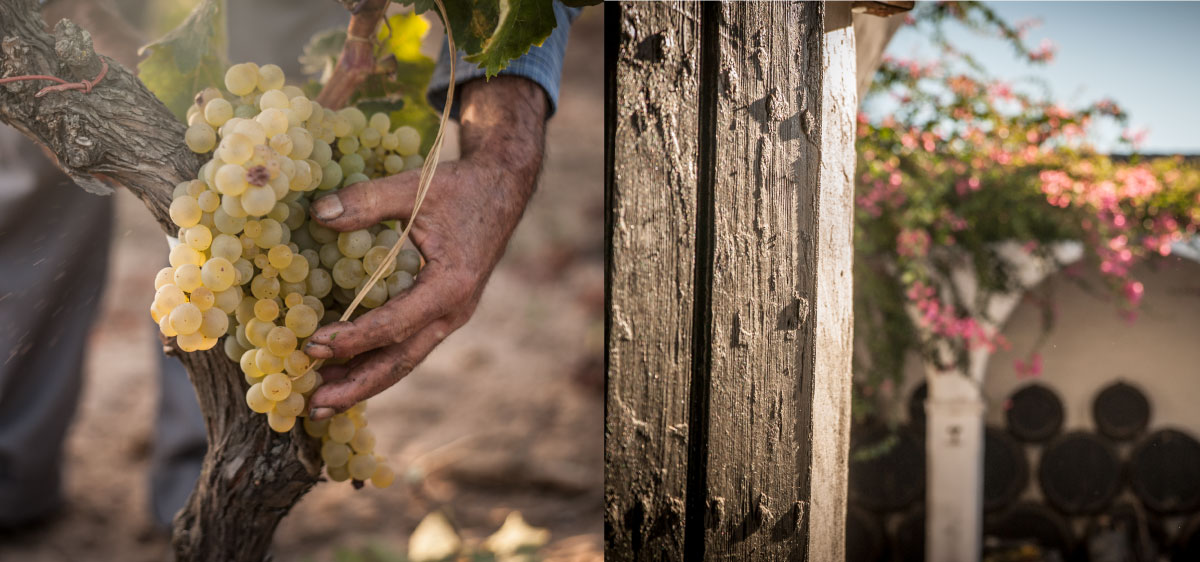
Their nature is complex and constantly subject to their owners’ personal decisions, based on, say, family traditions, or actual capacity.
Sadly, in past times, due to numerous social, economic and/or technical events, these stockholders have faced severe challenges that have diminished their overall significance, delegating them to a secondary position—far behind the majestic Sherry Houses—or worse, relegating them to a sort of parallel universe with little or no attention from outsiders. As an expert in the subject Sarah Jane Evans MW stated years ago: “It’s hard to find an Almacenista. Their bodegas are hidden behind anonymous doors in the sherry towns. You could walk past them and never know they were there”.

“It’s hard to find an Almacenista. Their bodegas are hidden behind anonymous doors in the sherry towns. You could walk past them and never know they were there”. – Sarah Jane Evans MW
THE JOB OF ALMACENISTAS OVER THE CENTURIES: HOW THE ROLE OF THE ALMACENISTA HAS CHANGED
According to archeological evidence though, Almacenistas enjoyed a much more relevant position in the past. Like Jerez as a whole, they have also lived through multiple events over the centuries, some of them quite tumultuous to say the least. Although the exact time of their origin isn’t clear because of their evolving essence and adaptability, we know they stood as a key force of the local industry for many decades, and their craftsmanship has clearly prevailed till our times. It’s around the late 1800s when everything seemed to start looking down.
By the mid-19th century, there were three distinctive organizations of people devoted to some of the processes, from grape-growing and wine production to sales: Cosecheros (growers), Almacenistas (winemakers/stockholders) and Extractores (traders). The first ones were focused on tending the vineyards and growing and harvesting the grapes. The second were taking care of vinifying the grapes and aging the wines for up to a decade or more. The third group were responsible for the marketing, selling, and shipping (overseas) of the wines produced by the other two.
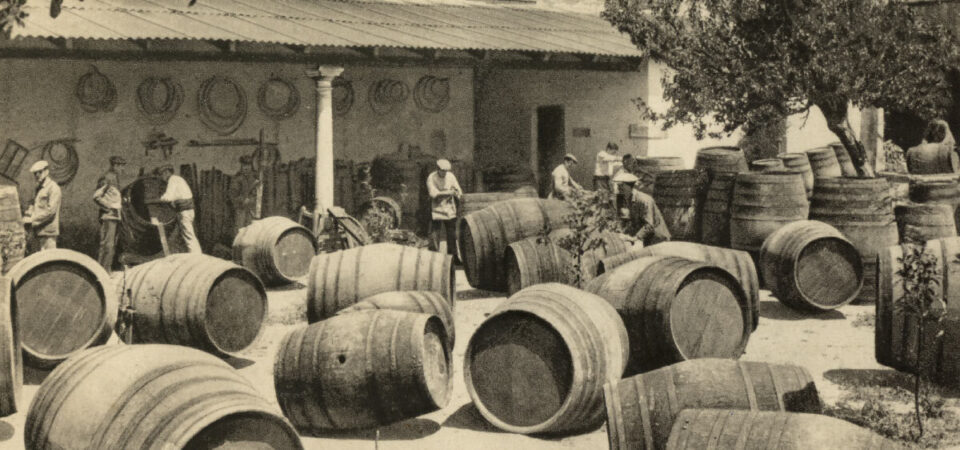
Through those times, the cultivation of the grapes seemed to stay fairly stable. On the other hand, as we explained in our previous article named: How is sherry aged?, the more extended añada aging method of the era commenced to transition into the currently-widely-utilized Sistema de Solera y Criaderas, a dynamic aging system that aimed to readily obtain wines with a higher degree of consistency. This, along with the invention of the “flor” wines in the early second half of the century, opened a chance for the Extractores to go about aging their own wines, putting great pressure on the Almacenistas which were used to supply the full sherry production to the traders who, in contrast, gradually restructured to take control of the entire winemaking process. As exports of younger wines increased, the Almacenistas’ power decreased. Used to the ‘simpler’ añada style wine production, many could not keep up with the higher costs essential to setting up the Solera Systems. Little by little, by 1863 they had lost most of their presence in the game.
Despite this dramatic change, and the consequent reduction in the number of Almacenistas in the region, these remarkable warriors remained active, and today—partly thanks to Lustau’s vision—still represent the top values and quality standards of the appellation.
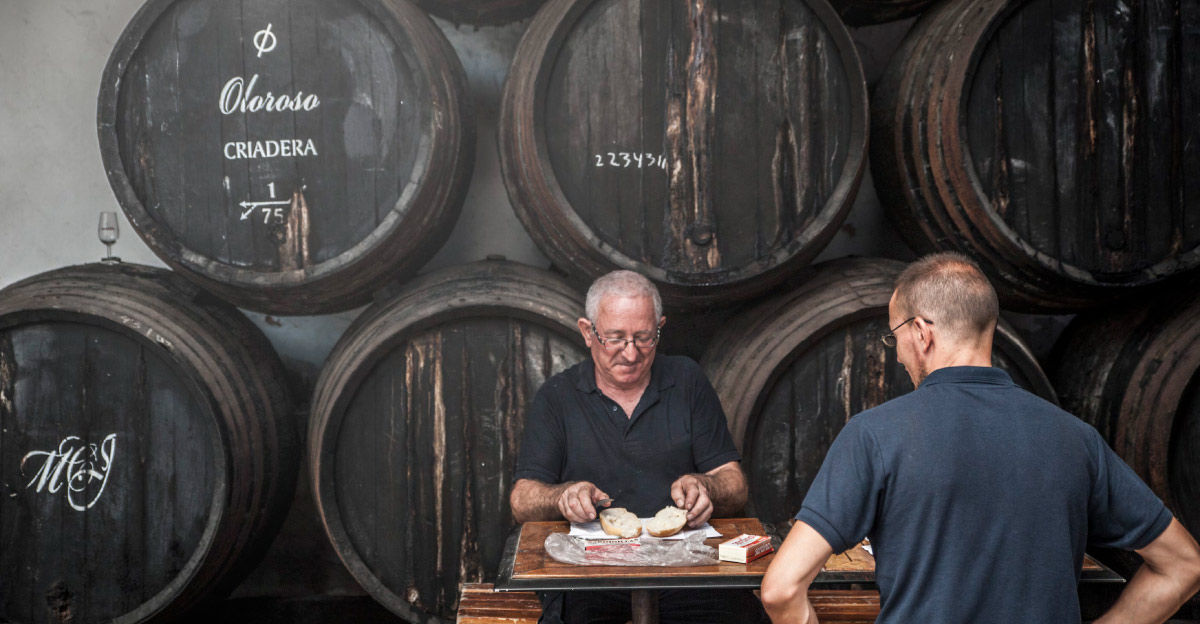
ALMACENISTAS’ ROLE IN THE REGION TODAY
Regardless of their lower influence these days, the impact on the annual end results of the overall wine Regardless of the lesser influence they exert these days, the impact on the annual end results of the overall wine production process that Almacenistas manage to hold is, once again, substantial. Today, the forefront of the Jerez trade structure is divided into two major players, each of them having their own well-defined functionality and duties that compel both to rely on each other: the sherry Exporters/Houses and the much rarer Almacenistas. Following the still current rules, all of them are located within the townships of Jerez de la Frontera, El Puerto de Santa María or Sanlúcar de Barrameda, and allowed to make wines under the two DOs: «Jerez-Xérès-Sherry» and «Manzanilla-Sanlúcar de Barrameda», yet with slightly different rights and capabilities. The former (minimum 2,500 hectoliters in permanent inventory) can produce and age—but also sell in bottles—wines under their own brands. The latter (only 500 hectoliters in permanent inventory is required), can also produce and age but cannot sell bottled (exported) sherry. Therefore, Almacenistas are left with two options, they either sell wine in bulk to the locals, or they vastly supply the Exporters/Houses with their stocks—this last option being an organic outcome of the internal trading structure of Jerez every year.
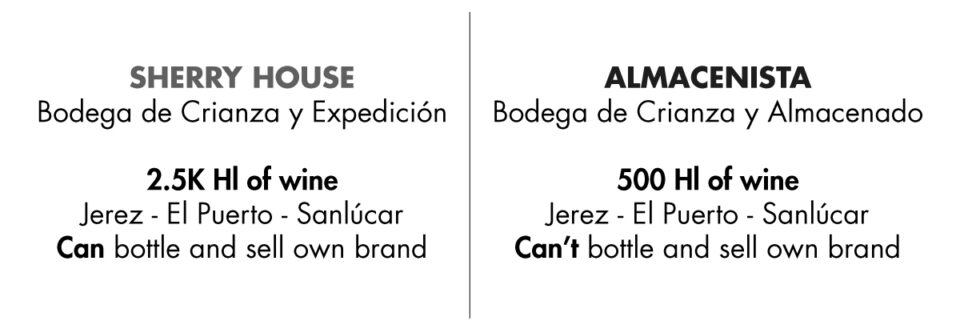
In 2021 there were formally identified 17 wineries as Bodegas de Crianza y Almacenado, most of them In 2021 there were, formally identified, 17 wineries as Bodegas de Crianza y Almacenado, most of them within the municipality of Jerez de la Frontera. Some of them actually acting as “sister companies” to large exporting sherry houses—reserving all their stocks exclusively for their bigger business partners—so in fact, the real number is even lower. Out of this reduced family, one can spot those names that have collaborated with Lustau over the years. Since the 1980s, Lustau has consistently brought to the fore fair volumes of limited sherries that have been aged by a variety of Almacenistas all over the region. The commitment has always been to market these wines pristine—untouched—showing their true signature all illustrated by the person in charge of their development over many years, decades in some instances. A long time has gone by since the first saca back in 1986, with many frequent releases giving them the opportunity to travel to territories far away from their aging bodegas. As our authority Sarah Jane Evans MW implied in the lines above, the most intimate, hidden, anonymous regional treasures were finally being exposed to the world. The names of the men and women responsible for such important generational assignment, and their superior products, have all been revealed at last.
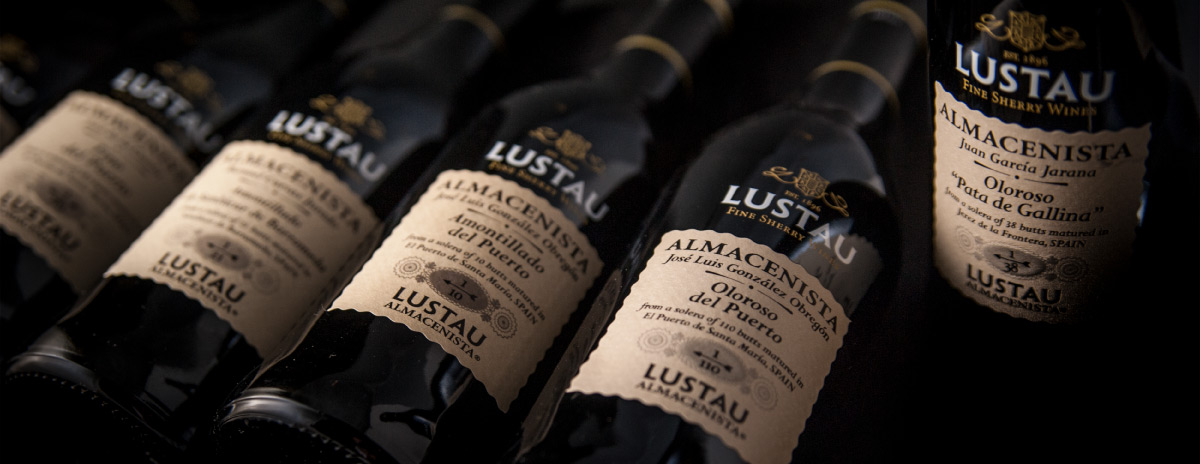
Since the 1980s, Lustau has consistently brought to the fore fair volumes of limited sherries that have been aged by a variety of Almacenistas all over the region.
The idea behind the Lustau Almacenista range is supported by strong alliances between Lustau and the rank of small wineries involved in the project. The mutual accordance and convictions—and the continued constructive feedback from the Lustau team led now by chief winemaker Sergio Martínez—will determine the character, quality, and varied profiles expressed by the class of wines. Currently, the line includes eight wines aged by five producers, although many more Almacenistas have taken part in the venture at some point in the past.
| Ángel Zamorano | Amontillado de Jerez 1/20 Ángel Zamorano |
| Ángel Zamorano | Oloroso 1/16, Ángel Zamorano |
| Cayetano del Pino | Palo Cortado Cayetano del Pino |
| José de la Cuesta | Fino de El Puerto 1/183, José de la Cuesta |
| José Luis González Obregón | Amontillado de El Puerto 1/10, González Obregón |
| José Luis González Obregón | Fino de El Puerto 1/143, González Obregón |
| José Luis González Obregón | Oloroso de El Puerto 1/110, González Obregón |
| Juan García Jarana | Amontillado de Jerez 1/51, Juan García Jarana |
| Juan García Jarana | Oloroso Pata de Gallina 1/38, Juan García Jarana |
| Manuel Cuevas Jurado | Manzanilla Amontillada 1/21, Manuel Cuevas Jurado |
| Manuel Cuevas Jurado | Manzanilla Pasada 1/80, Manuel Cuevas Jurado |
| Manuel Cuevas Jurado | Manzanilla Olorosa 1/39, Manuel Cuevas Jurado |
| María Luisa Coveñas | Dos Cortados, María Luisa Coveñas |
| Miguel Fontádez Florido | Amontillado de Jerez 1/30, Miguel Fontádez Florido |
| Miguel Fontádez Florido | Amontillado Fino de Jerez 1/47, Miguel Fontádez Florido |
| Miguel Fontádez Florido | Oloroso de Jerez 1/2, Miguel Fontádez Florido |
| Piaget | Amontillado Fino 1/75, Piaget |
| Pilar Aranda | Amontillado Fino de Jerez 1/16, Pilar Aranda |
| Pilar Aranda | Oloroso Añada 1918, Pilar Aranda |
| Pilar Aranda | Oloroso Añada 1930, Pilar Aranda |
| R. Benítez Girón | Amontillado de Jerez 1/2, R. Benítez Girón |
| R. Benítez Girón | Oloroso 1/3, R. Benítez Girón |
| R. Farfante | Dos Cortados 1/2, R. Farfante |
| Vides | Palo Cortado 1/50, Vides |
| Viuda de A. Borrego | Oloroso 1/138, Viuda de A. Borrego |
Some of the names on the above list continue to take an active role in the Lustau Almacenista offerings, others, unfortunately, have vanished forever. And a third group, following what Lustau did in the 1950s, decided to pursue the transition into a bodega de Crianza y Expedición by gently introducing wines under their own brands. The truth is, every listed Almacenista has unquestionably provided their input and proficiency, greatly contributing to the success and to the expansion of the House of Lustau and, more importantly, giving the rest of the world access to some of these very unusual liquid jewels.

Manuel Cuevas Jurado: Manuel Cuevas Jurado was an important grocer in Sanlúcar de Barrameda, who kicked off his career as a vintner in 1950 and started the four generations of his family-owned vineyards. After the death of Manuel Cuevas Jurado, his son and grandchildren have continued the business in memory of its founder.
Lustau Almacenista Manuel Cuevas Jurado Manzanilla pasada de Sanlúcar 1/80
Lustau Almacenista Manuel Cuevas Jurado Amontillado de Sanlúcar 1/21

José Luis González Obregón: José Luis began making wine in 1959 as a hobby after retiring from his job as general foreman of an export winery in Jerez.
Lustau Almacenista José Luis González Obregón Fino del Puerto 1/143
Lustau Almacenista José Luis Gonzalez Obregón Amontillado del Puerto 1/10
Lustau Almacenista José Luis González Obregón Oloroso del Puerto 1/110
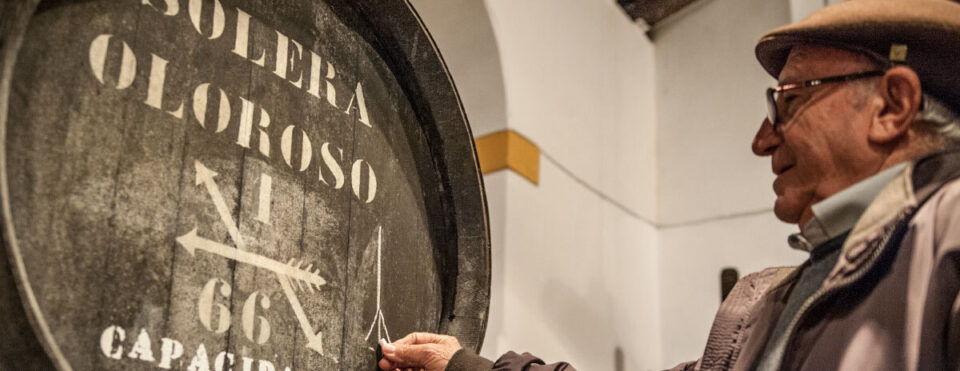
Juan García Jarana: García-Jarana’s winery, known as “El Aljibe”, is quaint, charming, and picturesque. The Lustau Almacenista Oloroso Pata de Gallina 1/38 ages in a solera in Jerez owned by Juan García-Jarana, whose cellar is located in the Santiago quarter. García-Jarana’s Sherries are renowned for their quality and include small soleras of Fino, Oloroso, Amontillado and Pedro Ximénez. Lustau selected the Pata de Gallina Oloroso in 1989 and it has subsequently become one of the most popular wines in the Almacenista range.
Lustau Almacenista Juan García Jarana Oloroso Pata de Gallina 1/38

Antonio Caballero y Sobrinos: At the end of the 19th century, Antonio established a few soleras of sherry that he maintained for decades for his private consumption with consumer devotion for over two decades. His nephews, “sobrinos” in Spanish, took over the business after Antonio retired and decided to continue his legacy as Almacenistas. In the 1960’s, the heirs of Antonio moved the most special soleras to a very unique location, the Castle of San Marcos, a landmark building in the historic center of El Puerto de Santa María.
Lustau Almacenista Antonio Caballero y Sobrinos Amontillado del Castillo 1/38
EVOLVEMENT OF LUSTAU FROM SHERRY ALMACENISTA TO SHERRY EXPORTER
To grasp the significance of these eight labels within the ample collection of wines marketed by Lustau today, it is necessary to look back at the origins of the firm. Lustau itself was established in 1896 as an Almacenista producer. José Ruiz-Berdejo, a secretary of the local Court of Justice, started cultivating the vines of the family’s state, named Nuestra Señora de la Esperanza, in his spare time. In these small-scale beginnings he made tiny quantities of wines which were then sold on to larger sherry producers. In 1931, his daughter, María Ruiz-Berdejo Alberti, acquired a little winery close to the center of Jerez de la Frontera and moved all the preexisting soleras there, gaining notoriety and visibility. In the 40’s, Maria’s husband, Emilio Lustau Ortega once again moved the winery to the old Santiago district in Jerez de la Frontera. There, in buildings that were part of the ancient Moorish walls of the city, he slowly began to expand the business, still as an Almacenista. Although, in 1945 Emilio Lustau stepped away from being an Almacenista by steadily introducing its own brands: Papirusa, Jarana, Escuadrilla, Emperatriz Eugenia and Cinta de Oro were some of them. In 1950, the company started to export its own sherry wines. 125 years on, the history written by the numerous winery capataces whose work, experience, and dedicated passion grew the company without breaking that connection with the Almacenista philosophy that José, María and Emilio set to themselves still rules the House; offering the world the unparalleled diversity of quality wine specialties coming out of Jerez. The Lustau Almacenista line hopefully pays homage to, not only, the humble origins of the winery, but also to those [otherwise] unknown heroes that, motivated by their love towards their craft, have contributed to the grace of the region ever since.
